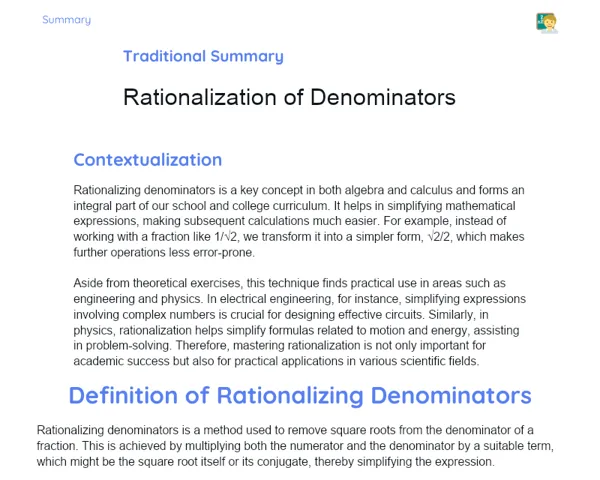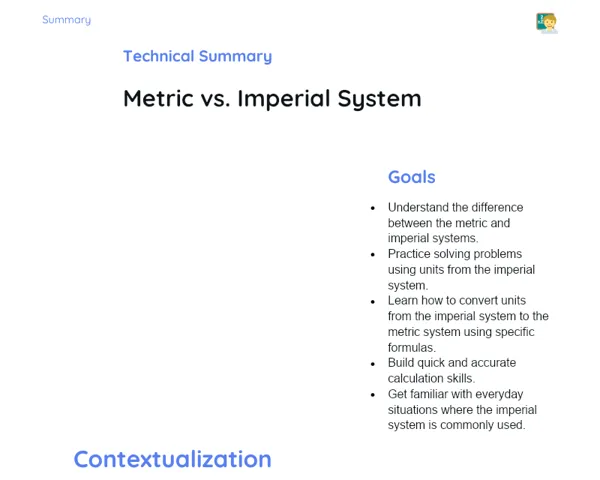Summary Tradisional | Spatial Geometry: Volume of the Cylinder
Contextualization
In this lesson, we will look into the concept of finding the volume of a cylinder, a common three-dimensional shape seen in everyday objects. A cylinder is defined by its two parallel and identical circular bases, joined by a curved side. We observe cylinders in items like soda cans, tumblers, pipes, and even in larger structures such as storage silos on farms.
Calculating the cylinder’s volume is a key mathematical skill, especially when dealing with measurements for capacity and storage. The formula used is V = πr²h, where ‘V’ is the volume, ‘r’ represents the radius of the circular base, and ‘h’ is the height of the cylinder. Knowing and applying this formula is vital for tackling problems related to cylindrical containers and finds use in fields like engineering, architecture, and the sciences.
To Remember!
Definition of the Cylinder
A cylinder is a three-dimensional figure that has two identical and parallel circular bases, connected by a smooth curved side. These bases are congruent and the distance between them is called the height of the cylinder. One can imagine the curved side as a rectangle wrapped around to join the two circles.
In mathematical terms, a cylinder consists of all points that are at a fixed distance (the radius) from a central line (the height). This definition helps us understand the features of a cylinder and lays the groundwork for calculating its volume.
Recognising the main characteristics, like the radius of the base and the height, is essential when applying formulas and solving relevant problems.
-
The cylinder has two parallel and identical circular bases.
-
The distance between the bases is known as the height.
-
The curved side connects the two bases.
Volume Formula for the Cylinder
To calculate the volume of a cylinder, we use the formula V = πr²h, where V denotes the volume, r is the radius of the circular base, and h is the height of the cylinder. Essentially, we multiply the area of the base (πr²) by the height (h) to arrive at the total volume.
This formula is based on the idea that the volume represents the three-dimensional space occupied by the cylinder. Since the base is a circle, we use the area formula for a circle, and then multiply it by the cylinder’s height to get the volume.
Having a solid grip on this formula is crucial for solving problems, be it determining the capacity of a can or figuring out the volume of a storage tank.
-
The formula for a cylinder’s volume is V = πr²h.
-
Calculate the area of the circular base using πr².
-
Multiply the base area by the height to get the volume.
Deriving the Formula
The volume formula comes from multiplying the area of the circular base by the height of the cylinder. Since the base is a circle with area πr² (where r is its radius), when we multiply that area by the cylinder’s height, we obtain the complete volume.
To visualise this, think of the cylinder as being made up of numerous thin circular slices stacked on top of one another. Each slice has the same area as the base, and the sum of the thicknesses of these slices equals the cylinder’s height. Multiplying one slice’s area by the total height gives us the volume.
This step-by-step derivation not only explains where the formula comes from, but it also helps us apply the concept to various practical problems involving cylinders.
-
The volume is derived by multiplying the area of the base with the height.
-
The base is a circle whose area is given by πr².
-
Multiplying these gives the complete volume.
Practical Examples and Applications
To deepen our understanding of the cylinder’s volume, it is useful to look at practical examples. For instance, consider a cylinder with a 3 cm radius and a 5 cm height. Using the formula V = πr²h, the area of the base would be π × (3)² = 9π cm², and the volume would thus be 9π × 5 = 45π cm³.
Real-life applications include calculating the capacity of cylindrical containers such as soda cans, fuel tanks, or storage silos in agriculture. These practical exercises help in planning and optimising space and resource utilisation.
By solving such examples, students can see how mathematical concepts are directly applicable to everyday situations, thereby reinforcing their learning.
-
Working through practical examples helps solidify understanding.
-
Applications include calculating volumes for containers and tanks.
-
Real-life relevance strengthens conceptual learning.
Key Terms
-
Cylinder: A three-dimensional figure with two parallel circular bases and a curved side.
-
Volume: The measure of space occupied by a figure.
-
Radius: The distance from the centre of a circle to its boundary.
-
Height: The distance separating the two bases of a cylinder.
-
Base Area: The area of a circle, computed using the formula πr².
-
Volume Formula: The calculation V = πr²h used to determine the volume.
Important Conclusions
In summary, this lesson covered how to calculate the volume of a cylinder—a three-dimensional shape featuring two identical circular bases connected by a curved side. We applied the formula V = πr²h, where ‘V’ is the volume, ‘r’ is the radius, and ‘h’ is the height, to determine the space occupied by the cylinder.
Understanding this formula, and how it derives from multiplying the area of the circular base by the cylinder’s height, is key to solving practical problems. Whether it’s finding the capacity of a fuel tank or a storage container, these concepts are highly relevant to everyday life.
The skill of calculating cylinder volumes is valuable in fields such as engineering, architecture, and science. I encourage students to explore further by applying these concepts in various practical scenarios, thereby strengthening their mathematical and spatial reasoning.
Study Tips
-
Revisit the formula V = πr²h and practice with different radius and height values to reinforce your understanding.
-
Observe everyday items that have a cylindrical shape and try computing their volumes. This hands-on practice can really bring the theory to life.
-
Make use of educational videos and interactive simulators available online for a deeper insight into the volume calculation and other geometric figures.



